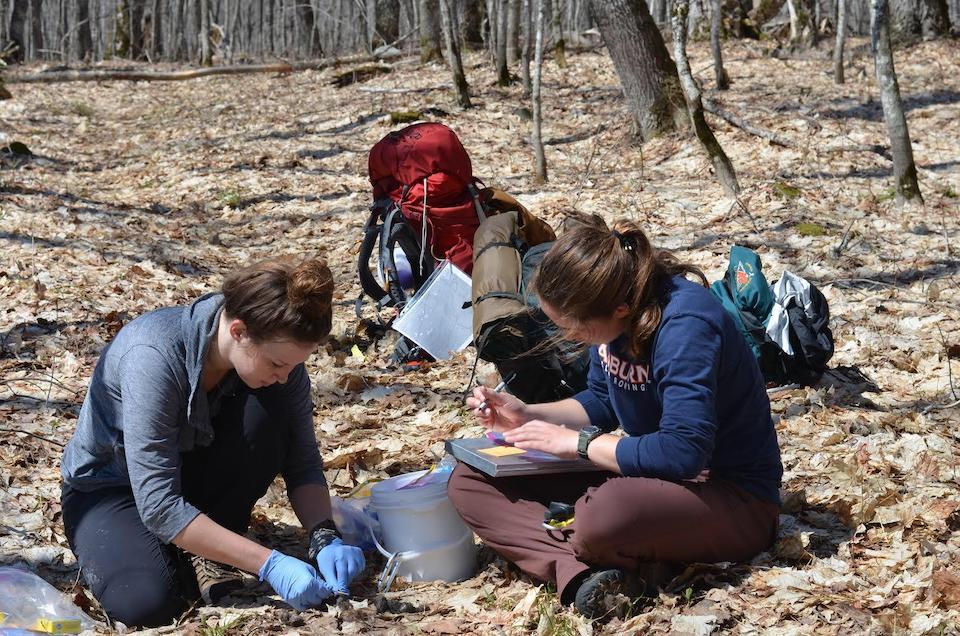
Wolf project technicians Megan Petersohn (left) and Cara Ratterman (right) sample wolf scat detected at wolf GPS cluster site, spring 2019, on Isle Royale/Courtesy of Tyler Petroelje, SUNY-ESF
With a burgeoning moose population at Isle Royale National Park, it shouldn't come as a great surprise that wolves relocated to the island this year have been targeting the ungulates for their meals.
Analysis of wolf scat piles this year has indicated that just a bit more than half of the prey taken by wolves were moose, while beavers and snowshoe hares also were taken by the carnivores.
The field work was done from the late spring into early fall by Park Service staff and personnel from the State University of New York – College of Environmental Science and Forestry. This work marked the first time wolf predation has been monitored on Isle Royale during snow-free periods, according to the Park Service. The monitoring effort utilized the most recent advances in the study of wolf predation patterns.
The researchers used GPS data from collars on the introduced wolves to identify “clusters” of locations that signified areas where wolves spent extended periods of time. Between May and October, field crews visited 381 of these sites, determined wolf behavior associated with site use, and located the remains of 60 prey, including primarily moose, beavers, and snowshoe hares.
Of the moose preyed upon, 63.4 percent were calves. Although not specifically designed to identify smaller prey, the predation monitoring also revealed the importance of beaver and snowshoe hare in the diets of wolves.
“Combining recent advances in technology with our knowledge of predator-prey relations will provide new insights, not only in the year-round foraging ecology of wolves on Isle Royale, but their overall role in this island ecosystem,” said Dr. Jerry Belant, a professor at SUNY-ESF and collaborative partner on wolf research.
Along with other research designed to identify ecosystem effects, the NPS and researchers from Michigan Technological University and SUNY-ESF will continue to document wolf predation each winter and summer to monitor the restoration of wolf predation, its effects on Isle Royale’s moose population, and more importantly, the health of the island community as a whole.
GPS data led to the discovery of 24 moose carcasses by investigators and volunteers associated with MTU that will assist their long-term research, specifically the reconstruction of moose population estimates over time. Rolf Peterson, a research professor from MTU who helps direct citizen science teams of "Moosewatch" volunteers in the field, said that "our team members found it fascinating to explore clusters of wolf locations from last winter and spring, trying to locate bones from moose that had been killed or scavenged by wolves."
In collaboration with several federal, provincial, state, tribal, and university partners, the Park Service is interested in investigating broad ecosystem change as the island adjusts to the return of predation, a key process in the ecosystem community dynamics of Isle Royale. This research will provide tangible evidence to help the NPS evaluate the success of its management actions as the project continues over the next few years.
“Restoring wolves is really about restoring integrity and resiliency to the ecosystem; making the ecosystem whole. Capturing the effects on the ecosystem as a result of our management actions is paramount to measuring the success of the program,” said Mark Romanski, natural resources chief at Isle Royale NP and project coordinator for the wolf translocation efforts.
The NPS and its collaborators will continue to monitor the new wolves as they settle into the island environment and to document ecosystem changes; wolf predation being just one of many metrics used to evaluate this ecosystem restoration effort.



Comments
Correction to "This work marked the first time wolf predation has been monitored on Isle Royale during snow-free periods, according to the Park Service." The first time was summer 1958. See 'The Wolves of Isle Royale," Table 10, page72.
I'm glad the wolves have made the trek from Minnesota. Usually, in the past, as I recall, eventually, they will die off due to inbreeding and the cycle will start all over again.
They didn't make the trek. They were brought in by humans.
I am thankful that the NPS finally reached the conclusion that restoration of a viable wolf population on Isle Royale is the best option available. The explosion of the moose population in recent years has had obvious effects on the ecosystem, and the logical extrapolation of this trend would be mass starvation of moose accompanied by unimaginable damage resulting from over-browsing. Let's hope that predation successfully reaches a balance in the near future.